Marc Alan Goodman’s Building Strange Weather Blog — Step One: Finding A New Home
WILLIAMSBURG, BROOKLYN: As far as small, privately-run recording studios go, my own Strange Weather has been pretty nomadic in its short lifespan. Since 2003 when I first opened under that name as a home studio in the suburbs of Philadelphia, Strange Weather has seen five different locations, each one a significant improvement over the last.
I returned to Philadelphia after spending five years in NYC as a student and musician with a plan to make recording music the rest of my life. The studio’s fourth incarnation saw a move back to NYC with a small, single room space in Greenpoint, and the fifth landed us in our current two-room, control-room-centric space in South Williamsburg.
Now, we’re preparing to make our largest and hopefully final move into a new space in Brooklyn, as well as to transition into a fully commercial enterprise. The new space is being designed by Wes Lachot, and will be acoustically viable to compete with the city’s most famous surviving rooms while pricing itself low enough to be affordable to the average musician. If that sounds like a tough spot to squeeze into then you’re starting to see why I’m writing this!
I’m hoping this blog will give home studio owners insight into how to apply professional and long-lasting design concepts to their own space while also giving potential commercial studio owners ideas on how to keep build costs as low as possible. So let’s start with a little bit of background…
WHY NOW? WHY GROUND UP?
Up to now, the focus at Strange Weather has been on building up a high-grade gear list while keeping overhead (and hence pricing) low. All of our previous spaces have been rentals and we’ve done our best to keep infrastructure costs to a minimum by seeking out spaces that already suit our needs as closely as possible. The business model has worked, and as we’ve opened our doors more and more to outside engineers they’ve been very happy with their experience. However there are a few major limitations to our current space.
First off our live room is very small. It’s large enough to record great sounding drums but not for the entire band to play together comfortably. Do most musicians really record that way nowadays? Not in my experience. However everyone wants to feel like they can, and I sure as hell want to be able to when possible. I’d say that about forty percent of our potential work gets turned away because the live room doesn’t meet the client’s needs.
The second major issue is that the control room is mostly untreated and no matter how much time I spend trying to make the room viable for outside engineers it still takes them time to adjust. Ideally, to run a commercial space I would like to have a control room that anyone can walk into, mix a song, and when they get, home have exactly what they expected. This is only possible in a room designed from the ground up to be acoustically accurate.
So, in order for the studio to continue to grow, we need to find a larger space and be able to invest in genuine infrastructure. As anyone who records sound knows the two most important factors in making a great recording are the source and the space it’s being made in. It’s more important than any microphone, any preamp, or any piece of gear. Without a good sounding source in a good sounding room, it’s nearly impossible to get a good sound. Strange Weather has come as far as it can investing in all of the other facets of the process and now, it’s time for the final, big move.
LEARNING THE BROOKLYN REAL ESTATE MARKET: PROPERTY TYPES, FAR RATINGS & MORE!
The first hurdle in moving the studio was, of course, finding the space itself. Rental properties pose a very difficult question for recording studios: How much can we afford to spend on build out if our lease is only for a limited period of time?
In NYC in particular, everyone has to assume that they’ll only be in a space as long as their initial lease. If things go well and you can stay then great, but realistically if business is good that means the space is now worth more than when you started which means the price is likely to go up. Knowing this, my goal was to purchase a property.
By being able to spread the construction costs across a 30-year mortgage rather than a five or ten-year lease we’ve opened up a whole world of possibilities, but everything we’re doing should be equally applicable to a long-term rental space.
Before even looking at our first building we had to assess what we could afford, and the ups and downs of different property types. Many of Brooklyn’s studios seem to be built in previous industrial properties, specifically lofts or warehouses. These have had the advantage of being relatively inexpensive per square foot as well as having few neighbors to bother with noise (or rather few noisy neighbors to bother the studio!).
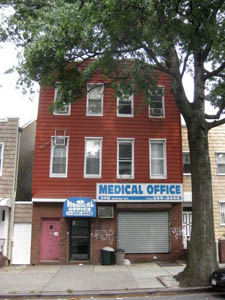
Strange Weather's new location is a 'mixed-use' property in Williamsburg, which formerly housed medical offices.
In addition, in most of these properties a recording studio would be considered “higher use,” which means that since it’s commercial rather than industrial, getting the necessary zoning adjustment should be a relatively simple. However, particularly in Williamsburg, these spaces have been rapidly disappearing over the last few years.
Rezoning and tax abatements have caused a boom in construction that revalued the land these buildings sit on at far more than what they’re worth as warehouses. In turn they’re mostly being torn down, and the price for the remaining ones has been driven through the roof. If you drive up and down nearly any street in this northern corner of Brooklyn you’ll see brand new condos built into every possible space. From my estimations it would be nearly impossible for a recording studio to compete with these condos in value per square foot. So even if we were lucky enough to find a long-term space it would be over the day the lease ran up.
The defining factor in this is a building’s FAR, or Floor-Area-Ratio. The FAR tells you how many times the buildings base square feet you can build. If a property has a FAR of 3 it can legally have three times the square footage of the lot. That means either three stories that take up the whole property, or six that only take up half of the ground floor, etc. If a building has a FAR of somewhere between 2 and 4 and you’re only using the ground floor you’re passing up on the majority of the lot’s value.
Most industrial buildings are only one story and end up being more valuable as tear-downs. The bigger ones are prohibitively expensive.
I looked at quite a number of industrial spaces and they presented both positive and negative qualities. Many of them had very high ceilings, which — even when taken down by a few feet to accommodate HVAC — would provide a very comfortable recording environment. Also, most of them already had commercial power and gas lines, as well as the additional rear exits required by fire code. But none of these things could overcome the value lost by not using up the available FAR.
The only way to make it work would be to sell the air rights of a property. Essentially, you can sell your unused FAR to other property owners within a limited area. However this only becomes viable when the building market is booming and since the city’s economic slowdown, these sales have come nearly to a halt.
Another option is to find a space that is already zoned “commercial,” specifically a storefront. Again, cost becomes a major issue in that these properties are highly sought out and mostly made up of actual storefronts. That means noisy neighbors, noisy traffic out front and high monthly costs. Also many of these spaces have the same lost value as the industrial buildings.
A relatively new development in this market is the commercial condo. They’ve been popping up around the city but as of now there’s only one in the Williamsburg / Greenpoint area. This could be an ideal space for a recording studio, but they have two major downfalls: first, they are in extremely close quarters with up to six potentially noisy neighbors and second, most new large developments are built very poorly.
PUTTING YOURSELF IN THE RIGHT PLACE AT THE RIGHT TIME
What we finally settled on is a mixed-use property. Much of Williamsburg has been rezoned as mixed-use in the last few years and many spaces on residential or commercial blocks are grandfathered in that way.
What mixed use means, in short, is that the space contains both commercial and residential properties, such as a store with apartments above it. This way, the ground floor can be used as the studio while the additional air space is still providing income as residential rental properties. The other upside of this type of building is that many of them are located on quieter, more residential streets.
Most realtors’ first reactions to my looking for a recording studio space was to suggest somewhere that neighbors would not mind the noise. However what we really want is a quiet environment where outside noise won’t be bothering us! If we do our job properly soundproofing the place noise shouldn’t be a problem to the neighbors anyway, and it’s a lot easier to keep the sound of a drum kit in than it is to keep trucks passing or the elevated train out.
Searching for the property itself was a long, slow process. Most sources for commercial listings are not very organized. As opposed to residential, most commercial buildings are not exclusively listed with one realtor. And the realtors themselves can be tough. Most of them seemed to be trying to sell whatever they could as quickly as possible and weren’t willing to spend time identifying my personal needs. However, with a purchase this size I really couldn’t rush it. From the time I looked at my first building, it was nearly two years before I found Strange Weather’s new location.
Internet searches and Craigslist in particular led me to a huge number of realtors and privately sold buildings that I wouldn’t have found elsewhere, but it’s also mostly filled with the same repetitive spam and can be tough to sort through.
I also spent days at a time riding around the neighborhood on my Vespa writing down the phone numbers on “for sale” signs. While this didn’t lead to any particularly helpful results in my case, I can only imagine that it’s where the best deals lie: going directly to aging owners who don’t really know or care exactly what their property is worth. A lot of it is about being in the right place at the right time.
In the end I found my new property through an unlinked web page on a realtors site. I happened to be fishing through Google and came across it before it went live. Frank at Castoria Realty in Williamsburg was extremely helpful, and I found myself in a classic Brooklyn situation where the current owner owed someone a lot of money and had to sell fast. After years of searching I finally found myself in the right place at the right time and ended up with a building I think is viable.
GRAHAM AVENUE, HERE WE COME.
The last thing to do before committing to the purchase was to have the building inspected. Hal Einhorn at Old House Inspections had come with me to look at a number of earlier properties and was extremely helpful in teaching me what to look for. The current space was at one point a doctor’s office, but I encourage you to imagine a doctor’s office that would fit in the basement of the mother’s house in Psycho. The pictures should speak for themselves.
Most of the building needs to be gutted to the bone, but since I would be doing that anyway in order to properly soundproof the studio this was almost an advantage — my hand is forced into doing it right the first time. In addition to dirt and grime, the previous owners left a Plinth and a fully functioning 1950’s GE X-ray machine! I’m still toying with the idea of gutting it and using it as a really creepy mic closet.
Check back next time for details on how I selected my team of studio designer, architect, and structural engineer. Feel free to email if you have any specific questions, or comment below, and I’ll try to cover those as well.
Marc Alan Goodman
strangeweathersound at gmail dot com
http://strangeweatherbrooklyn.com
Marc Alan Goodman is a producer/engineer who’s worked with artists such as Jolie Holland, Marc Ribot Shudder to Think, Dub Trio, Normal Love, Alfonso Velez, Angel Deradoorian and Pink Skull.








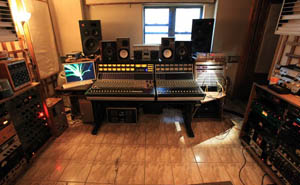
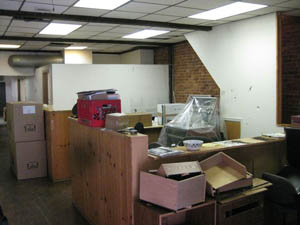
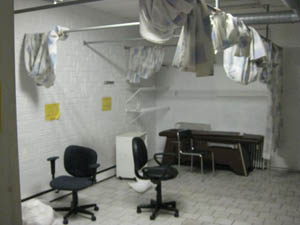
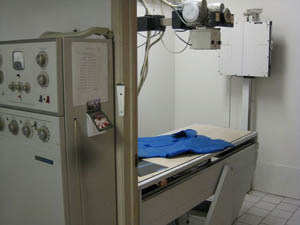
EL Botox
August 16, 2010 at 5:00 pm (14 years ago)Dude I love this! you know I’m first in line for Demolition work
EL Botox
August 16, 2010 at 10:00 am (14 years ago)Dude I love this! you know I’m first in line for Demolition work
Chet
August 16, 2010 at 8:21 pm (14 years ago)You Da Man!!
Chet
August 16, 2010 at 1:21 pm (14 years ago)You Da Man!!
Julian Silva
August 19, 2010 at 4:41 pm (14 years ago)Congratulations! Let me know if you need help!
Julian Silva
August 19, 2010 at 9:41 am (14 years ago)Congratulations! Let me know if you need help!